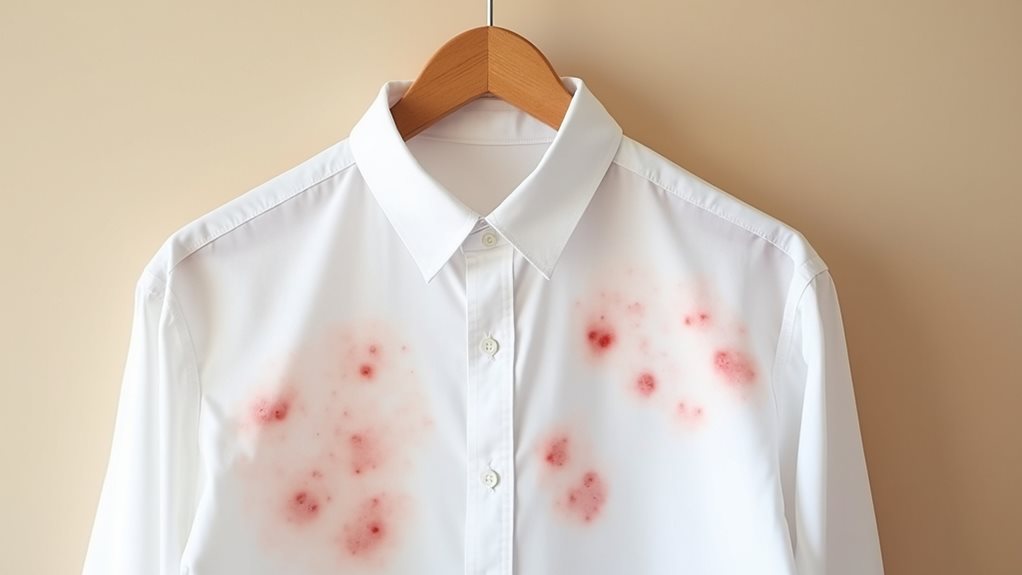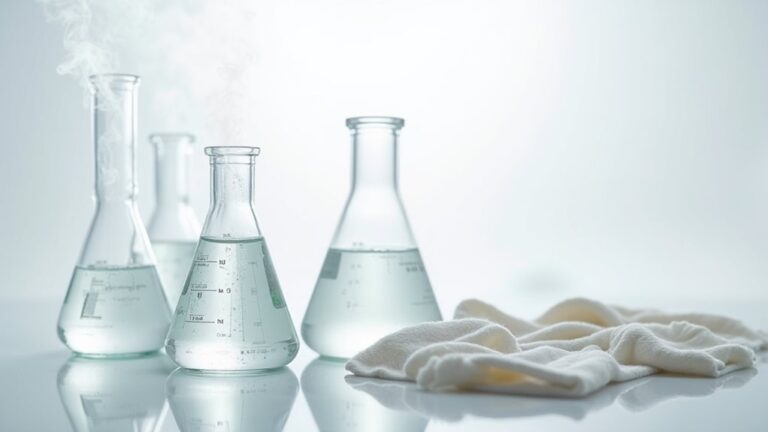You can absolutely develop a rash from dry cleaning chemicals, and if you’ve ever experienced mysterious skin irritation after wearing freshly cleaned clothes, those harsh solvents like perchloroethylene are likely the culprits behind your discomfort. These chemical residues linger on fabric fibers even when your garments smell fresh and clean, triggering reactions ranging from mild redness to intense itching that can appear hours or even days later. Understanding which chemicals cause these reactions will help you protect your skin going forward.
Understanding the Connection Between Dry Cleaning and Skin Reactions
Your skin’s basically having an allergic reaction to the chemical residues that cling to fabric fibers, and those irritants don’t magically disappear just because your clothes smell fresh.
If you’ve got existing conditions like eczema, you’re even more vulnerable to these sneaky chemical culprits that turn your wardrobe into an unexpected source of discomfort.
The most common symptoms include redness, itching, and burning sensations that develop where your treated clothing makes contact with skin.
Chemical Culprits: Perchloroethylene and Other Irritants
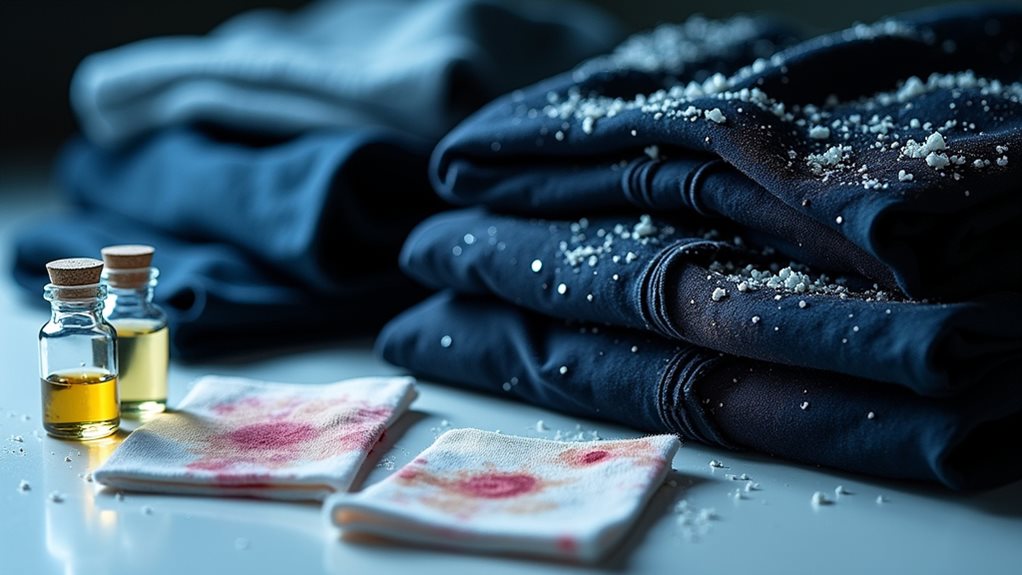
When you drop off your favorite blazer at the dry cleaner, you’re probably not thinking about the chemical cocktail that’s about to treat your clothes, but understanding these invisible culprits can help you protect your skin from unwanted reactions.
Perchloroethylene, or “perc” as it’s known in the industry, stands as the main villain in this story – a powerful solvent that can turn your freshly cleaned garments into skin irritation magnets, especially when those fumes haven’t had enough time to dissipate.
Beyond perc, you’ll also encounter a supporting cast of troublemakers including harsh detergents and precleaning agents, plus the not-so-pleasant reality that reused solvents can pick up a cocktail of previous customers’ body oils and dirt along the way.
The EPA has classified PERC as a probable human carcinogen, linking it not only to potential cancer risks but also to neurological problems and liver damage that go far beyond simple skin irritation.
Perc’s Toxic Properties
Although dry cleaning seems like a harmless service that keeps our favorite clothes looking pristine, the chemical reality behind those crisp garments tells a much more troubling story.
Perc isn’t just another cleaning chemical—it’s classified as a probable human carcinogen, which means even small exposures can potentially impact your health over time.
When you slip on that freshly cleaned blazer, residual perc can evaporate directly onto your skin, triggering skin irritation that ranges from mild redness to more serious allergic reactions.
The worst part? You mightn’t even realize what’s causing your sudden dermatitis flare-up. Those toxic fumes don’t just disappear; they linger on fabric fibers, creating a perfect storm for sensitive skin to react poorly.
Fortunately, many modern dry cleaners now offer eco-friendly solvents and alternative cleaning methods that significantly reduce the risk of chemical exposure and skin reactions.
Common Cleaning Chemicals
While perc dominates the conversation about dry cleaning dangers, it’s hardly the only chemical villain lurking in your freshly pressed clothes.
Your skin reacts to a cocktail of irritants that most people never consider, and honestly, I wish someone had warned me before my first allergic reaction 😅.
Common irritants you’ll encounter include:
- Detergents and bleaching agents that strip away natural oils
- Pre-cleaning solvents designed to tackle stubborn stains
- Reused chemical mixtures contaminated with previous customers’ oils and dirt
- Residual vapor emissions that continue releasing irritants long after cleaning
These common causes of allergic reactions create perfect conditions for contact dermatitis, especially if you’re already sensitive to chemicals.
The frustrating part? These irritants often work together, making it difficult to pinpoint exactly what’s causing your discomfort.
Workers in dry cleaning facilities face significantly higher exposure levels to these chemicals compared to consumers, which explains why respiratory irritation and skin sensitivities are more commonly reported in occupational settings.
Reused Solvent Risks
The dirty secret that most dry cleaners won’t tell you is how their “recycled” solvents become increasingly contaminated with each use, creating a toxic soup that your skin absorbs every time you slip on that freshly cleaned blouse.
These reused solvents accumulate body oils, dirt, and perspiration from countless previous garments, transforming what should be a cleaning solution into a cocktail of irritants.
When you wear these clothes, chemical residues transfer directly onto your skin, potentially triggering allergic reactions that range from mild itching to angry red welts.
I learned this the hard way after developing mysterious rashes that appeared only after wearing certain dry-cleaned items – turns out my skin was basically having a revolt against contaminated solvent buildup! 😅
Fortunately, many eco-friendly cleaning methods like wet cleaning and CO2 cleaning are now available as safer alternatives that reduce the risk of skin irritation.
Types of Skin Reactions From Dry Cleaning Exposure
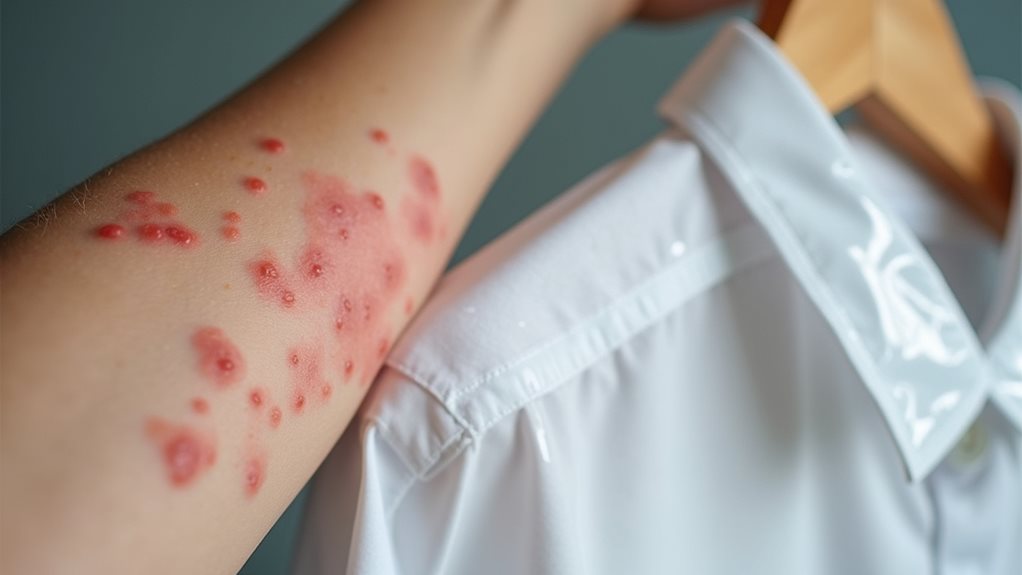
When those harsh dry cleaning chemicals meet your skin, you’re likely dealing with one of two main troublemakers: irritant contact dermatitis that strikes immediately after exposure, or allergic contact dermatitis that sneaks up on you hours or even days later like an unwelcome surprise guest.
Your skin might respond with angry red patches, stubborn swelling, or that maddening itch that makes you want to scratch until you’re raw – and trust me, I’ve been there after picking up a “fresh” suit that reeked of perchloroethylene.
The tricky part is figuring out whether you’re experiencing a direct chemical burn-like reaction from irritants, or if your immune system has decided to throw a full-blown tantrum against specific allergens lurking in those cleaning solvents.
These reactions occur because chemical residues can linger on your clothing even after the dry cleaning process is complete, continuing to irritate your skin with every wear.
Chemical-Induced Contact Dermatitis
Although I’ve always considered myself someone with fairly resilient skin, I learned the hard way that dry cleaning chemicals don’t discriminate when it comes to causing chemical-induced contact dermatitis.
When perchloroethylene and other harsh solvents meet your skin, they can trigger uncomfortable allergic reactions that’ll have you questioning every freshly cleaned garment in your closet.
Here’s what you need to watch for:
- Red, itchy patches appearing where clothing touches your skin
- Swelling or raised bumps that develop hours after wearing dry-cleaned items
- Burning sensations or unusual sensitivity in affected areas
- Worsening symptoms if you already deal with eczema or sensitive skin
To minimize exposure, always air out your clothes before wearing them, and don’t hesitate to ask your cleaner about gentler, hypoallergenic alternatives. Residual chemicals left on clothing after inadequate rinsing or insufficient ventilation can make these reactions even worse for those with chemical sensitivities.
Allergic Reaction Symptoms
Three distinct types of skin reactions can emerge from dry cleaning exposure, and I’ve witnessed each one firsthand during my years of helping people steer through these frustrating chemical sensitivities.
You’ll most commonly encounter allergic contact dermatitis, where your immune system fundamentally throws a tantrum after recognizing perchloroethylene and other common allergens as threats—think angry red patches that itch like crazy.
Then there’s irritant contact dermatitis symptoms, which develop when harsh chemicals directly damage your skin barrier, creating that telltale dry, cracked appearance that honestly makes me wince every time.
The tricky part? These skin reactions can show up hours or even days later, making you feel like a detective trying to solve your own mysterious rash case! 🕵️
Beyond skin irritation, exposure to these solvents can also trigger other concerning symptoms like dizziness and headaches, particularly when residual chemicals remain on freshly cleaned garments.
Irritant Exposure Effects
Since my neighbor Sarah first showed me her arms after picking up her favorite blazer, I’ve become acutely aware of how brutally irritant exposure can assault your skin in ways that honestly make allergic reactions look like child’s play.
When an irritating substance like perchloroethylene hits your skin, it doesn’t need your immune system’s permission to wreak havoc. This common chemical causes contact dermatitis through direct damage, leaving you with angry, swollen patches that look disturbingly burn-like.
If you’ve got sensitive skin, even minimal exposure can trigger painful cracking and inflammation.
- Red, swollen skin that resembles burns
- Painful dryness and cracking
- Localized inflammation and itching
- Chronic sensitivity from repeated exposure
The scary part? It happens faster than you’d expect.
Beyond immediate skin irritation, PERC can cause respiratory irritation and neurological symptoms with prolonged exposure, making proper ventilation in dry cleaning facilities crucial for worker safety.
Who Is Most at Risk for Developing Rashes

If you’ve ever slipped into a freshly dry-cleaned blazer only to find yourself scratching at mysterious red patches hours later, you’re definitely not alone in this frustrating experience.
Your skin’s reaction to those chemical cleaners depends largely on who you’re and what baggage your body brings to the table. If you’re already dealing with eczema or sensitive skin, you’re basically walking around with a “welcome mat” for contact dermatitis 🙈.
Your skin’s pre-existing conditions basically roll out the red carpet for dry cleaning chemicals to wreak havoc.
Those with allergies to specific chemicals face an even trickier situation, developing contact reactions when allergens from dry cleaning processes linger on fabric.
Healthcare workers and dry cleaning employees who regularly handle treated garments also face heightened risks from repeated exposure.
Dry cleaning workers face the most significant exposure to perchloroethylene and other solvents that can cause skin irritation and more serious health concerns.
Identifying Symptoms of Dry Cleaning-Related Dermatitis
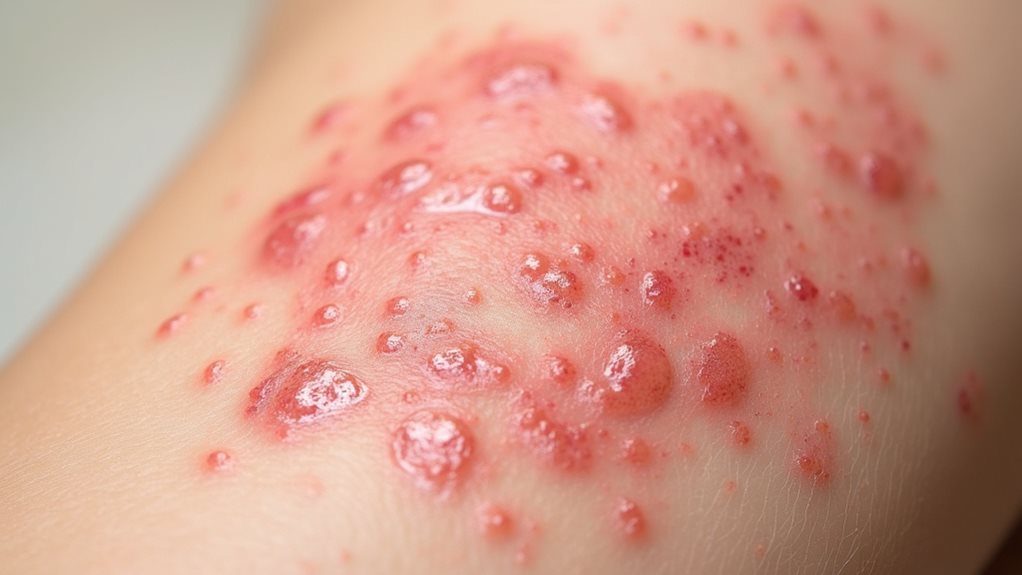
The telltale signs of dry cleaning-related dermatitis aren’t exactly subtle once you know what you’re looking for, though they can easily masquerade as other skin issues if you’re not connecting the dots.
When your immune system responds to cleaning solvents, you’ll typically notice symptoms appearing within hours or even days after wearing freshly dry-cleaned clothes.
Here’s what to watch for:
- Red, inflamed patches where fabric touches your skin most directly
- Persistent itching that seems worse than your average skin irritation
- Swelling around contact areas like your neck, wrists, or waistline
- Burning or stinging sensations that feel different from typical rash discomfort
The dermatitis often shows up in patterns that mirror your clothing’s contact points, making it easier to identify once you start paying attention to timing and location.
Choosing Eco-Friendly Dry Cleaning Alternatives

When you’re tired of playing chemical roulette with your wardrobe, switching to eco-friendly dry cleaning alternatives becomes less about following trends and more about protecting your skin from another round of angry, red welts.
Your wardrobe shouldn’t feel like a chemistry experiment gone wrong – especially when your skin pays the price.
Look for cleaners using liquid carbon dioxide or silicone-based solvents instead of perchloroethylene, which loves triggering allergic reactions like it’s going out of style.
These eco-friendly cleaning techniques rely on biodegradable solvents that won’t leave chemical residues clinging to your clothes like unwanted house guests.
Ask about hypoallergenic cleaning agents – they’re your skin’s best friend when you’re dealing with sensitivities.
Check certifications too, because legitimate eco-friendly cleaners proudly display their credentials like merit badges.
Prevention Strategies for Sensitive Skin

Beyond finding the right cleaner, you’ll want to build a fortress of protection around your sensitive skin, because let’s face it – even the best eco-friendly cleaners can sometimes leave traces that make your skin throw a tantrum.
These prevention strategies become your skin care lifeline when you’re dealing with potential allergens lurking in freshly cleaned garments.
Here’s your sensitive skin survival kit:
- Air out everything – Give dry-cleaned clothes a full 24-hour breather in well-ventilated spaces before wearing
- Choose breathable storage – Use garment bags that let air circulate while keeping dust mites away
- Stick with fragrance-free detergents – Your skin doesn’t need perfumed surprises when washing undergarments
- Moisturize after wearing – Apply gentle lotion to create a protective barrier against lingering chemical residues
Treatment Options for Dry Cleaning Rashes
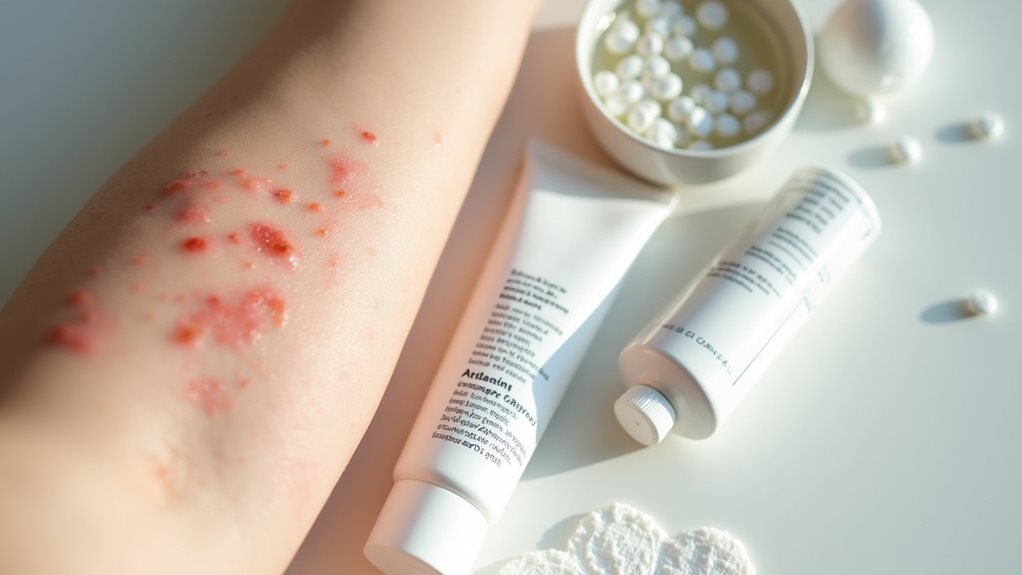
Once that angry red rash decides to crash your skin party, you’ll need a game plan that’s both swift and gentle, because nobody has time to walk around looking like they wrestled with poison ivy when all they did was pick up their favorite blazer.
Your treatment arsenal should start with topical corticosteroids, which work like tiny firefighters dousing the inflammation that’s making you miserable. Antihistamines can calm those allergic reactions while you’re plotting your next move, and trust me, gentle moisturizers will become your new best friends for restoring your skin’s natural defenses.
For severe cases, oral corticosteroids might join the party, though most rashes respond beautifully to the gentler approach.

